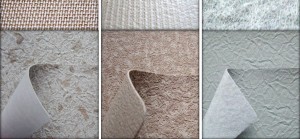USA: 1-800-338-3568 | CANADA: 1-866-591-5594

Vinyl Decking – Understanding the Difference in Backing Types
There are 3 different types of backing for vinyl decking…each with their own unique advantages and disadvantages. If manufactured by a reputable company, each type can have roofing approval and each type is perfectly suitable for your deck.
What is actually more important than the type of backing on the vinyl is the quality of the contractor installing it. As the saying goes … “A bad Contractor can screw up even the best of products.”
There is a woven cloth backing, a non-woven backing (referred to as fuzzy-backed), and a PVC backed product. A good contractor will be able to do a good job with any of these three backing types.
Characteristics of Each Backing Type
Download “Compare Membrane Backing Options” (.pdf) for an overview of the following information.

Woven Back – Type 3 (non-embedded fabric) Class B (exposed roofing) Membrane
Adhesion – Adhesive sticks well to woven backing and contact adhesives used allow for a wide window of application in all seasons (but be aware contact adhesives are product specific and not available “off the shelf”).
Heat Welding – Manufactured with a solid color throughout which helps create a solid “bleed out”. The fabric backing melts away to create a strong vinyl-to-vinyl weld. Welding results exceed industry standards, but requires more skill to master installation techniques.
Details – Fabric backing can be removed and vinyl easily manipulated for successful detailing. Standard details are easily attainable without extra preparation or expensive, pre-manufactured details.
Other – Easier to work with in hot weather with a good combination of strength and elasticity. Because skill for installation is mandatory, Duradek (followed by some other manufacturers of woven back vinyl) is only sold to trained contractors, and not available to the general public.
Non-Woven Back – Type 3 (non-embedded fabric) Class B (exposed roofing) Membrane
Adhesion – Adhesive sticks well to fibers, and while the adhesive is typically less expensive, this backing can “suck up” the adhesive so will use more, and sometimes excessive glue will cause bubbles.
Heat Welding – Fibers on the backing can be melted off with the heat gun to allow a vinyl-to-vinyl weld and reasonable welds can be achieved by an experienced applicator. Involves a few more steps as the fuzz has to be “buzzed”, and can take a longer time to master the installation techniques.
Details – Without center reinforcement, it is an easier membrane to detail with, but because the fuzz wicks water, you have to remove it or saturate the cut exposed ends at flashings, drains, etc. with glue.
Other – It is usually a less expensive system, but if there is any waterproofing breach in the membrane, water can wick though the fibers (if not properly coated with adhesive) causing rot. Depending on the substrate, repositioning the membrane can be difficult as it will stick like Velcro to rough plywood, when without being glued. In hot weather, the vinyl will “creep” when being smoothed out during application. It is often sold as a “cash & carry” product so available to untrained individuals.
PVC Back – Type 4 (embedded fabric) Class B (exposed roofing) Membrane
Adhesive – Adhesive is typically expensive and there is no second chance if weld area is contaminated with glue. Contact adhesive has a short “working window” making it difficult to use in bad weather or off-season.
Heat Welding – The weld is strong as there is no fabric barrier and it is the easiest to master installation techniques; however different coloured ply makes for bad “bleed out” on welds.
Details – Center reinforced vinyl is more difficult to bend for detailing. Due to the difficulty to adopt to 90˚ bends, PVC metal and pre-made corner boots are required for proper waterproofing detailing.
Other – Because of its conventional “roofing” construction, it is the preferred membrane of some specifiers, but as a deck surface has some disadvantages such as a higher chance of delamination and it is difficult to hide sub-surface blemishes due to the hard surface. Additionally, UV/Mildew inhibitors are only on the top ply where in fabric backed membranes it goes all the way through the PVC.
 Download “Compare Membrane Backing Options” (.pdf) for an easy-to-follow overview.
Download “Compare Membrane Backing Options” (.pdf) for an easy-to-follow overview.
To be referred to a Duradek vinyl decking expert in your area about your specific decking needs, contact us to request a free, no-obligation estimate.
Originally published November 4, 2015



